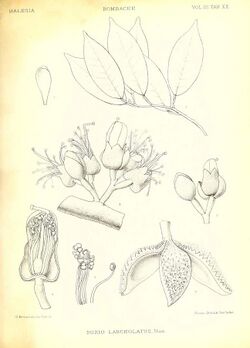Biology:Durio lanceolatus
| Durio lanceolatus | |
|---|---|

| |
| Scientific classification | |
| Kingdom: | Plantae |
| Clade: | Tracheophytes |
| Clade: | Angiosperms |
| Clade: | Eudicots |
| Clade: | Rosids |
| Order: | Malvales |
| Family: | Malvaceae |
| Genus: | Durio |
| Species: | D. lanceolatus
|
| Binomial name | |
| Durio lanceolatus Mast.[2]
| |
Durio lanceolatus is a tree in the family Malvaceae. It grows up to 55 metres (180 ft) tall.[1]
Distribution and habitat
Durio lanceolatus is endemic to Borneo. Its habitat is mixed dipterocarp forests, at altitudes to around 1,100 m (4,000 ft).[1]
Uses
Durio lanceolatus is a source of durian timber, used in construction and furniture. The fruit of this species is not considered edible.[1]
Conservation
Durio lanceolatus has been assessed as near threatened on the IUCN Red List. The species is threatened by logging for its timber and conversion of forests for agricultural uses. Such conversions have increased the risk of fires. Mining is a threat in Kalimantan. Durio lanceolatus is found in protected areas including Gunung Mulu National Park and Gunung Gading National Park.[1]
References
- ↑ Jump up to: 1.0 1.1 1.2 1.3 1.4 Chadburn, H. (2018). "Durio lanceolatus". IUCN Red List of Threatened Species 2018: e.T34569A120270279. doi:10.2305/IUCN.UK.2018-2.RLTS.T34569A120270279.en. https://www.iucnredlist.org/species/34569/120270279. Retrieved 20 November 2021.
- ↑ "Durio lanceolatus Mast.". Royal Botanic Gardens, Kew. http://powo.science.kew.org/taxon/urn:lsid:ipni.org:names:559519-1.
Wikidata ☰ Q15367334 entry
 |


